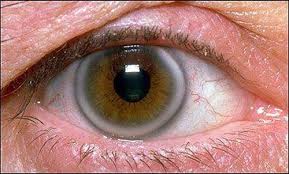
Arcus senilis (AS), are rings in the peripheral cornea.
It is usually caused by cholesterol deposits.
It is the most common peripheral corneal opacity, and is usually found in the elderly where it is considered a benign condition.
When AS is found in patients less than 50 years old it is termed arcus juvenilis.
In combination with hyperlipidemia in younger men represents an increased risk for cardiovascular disease.
It is caused by leakage of lipoproteins from limbal capillaries into the corneal stroma.
It consists mostly of low-density lipoprotein (LDL).
Deposition of lipids into the cornea begins at the superior and inferior aspects, and progresses to encircle the entire peripheral cornea.
Bilateral AS is a benign finding in the elderly, but it can be associated with hyperlipidemia in patients less than 50 years old.
Bilateral AS may also be caused by increased levels of free fatty acids in the circulation secondary to alcohol use.
Unilateral AS can be associated with contralateral carotid artery stenosis or decreased intraocular pressure in the affected eye.
Itis usually diagnosed through visual inspection.
Other conditions with similar appearance, but differing in color are limbal ring, and Kayser–Fleischer ring.
In the elderly, arcus senilis is a benign condition that does not require treatment.
Its presents in young men is a risk factor for cardiovascular disease,and these individuals should be screened for an underlying lipid disorder.
The opaque ring in the cornea does not resolve with treatment of a causative disease process.
In men, AS is increasingly found starting at age 40.
AS is present in nearly 100% of men over the age of 80.
For women, onset of AS begins at age 50 and is present in nearly all females by age 90.
The presence of AS in men less than 50 years old in combination with an underlying condition causing hyperlipidemia has been shown to significantly increase the relative risk of mortality from cardiovascular disease and coronary artery disease,
The presence of AS in men less than 50 years old in conjunction with xanthomas on the achilles tendon has been linked to the presence of atherosclerosis in the coronary arteries and aorta.
